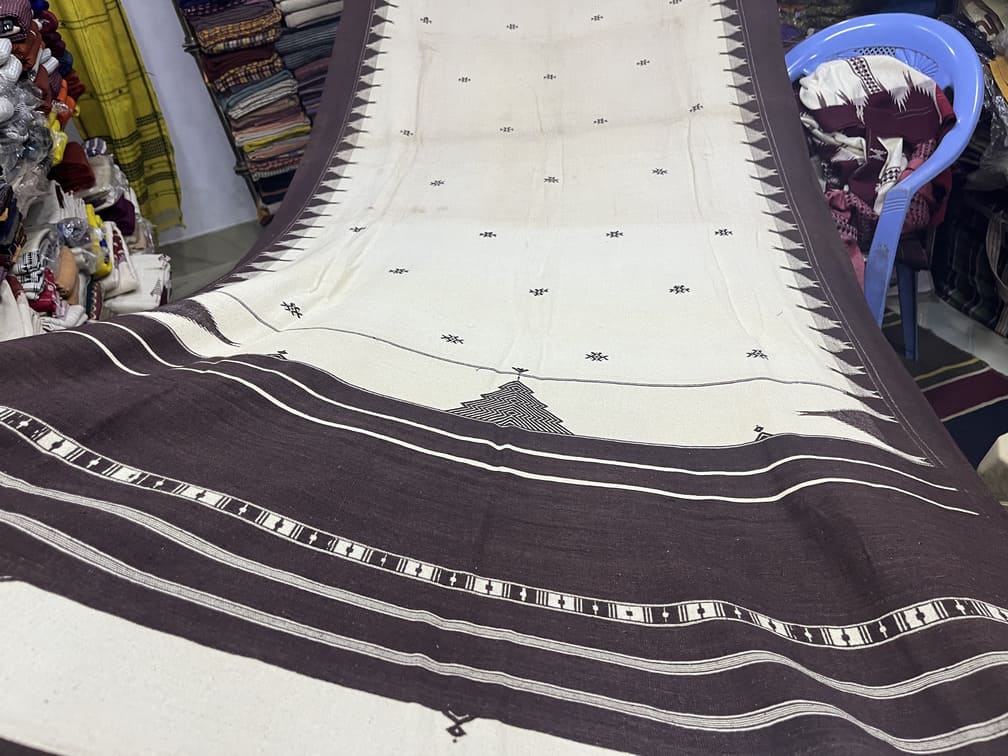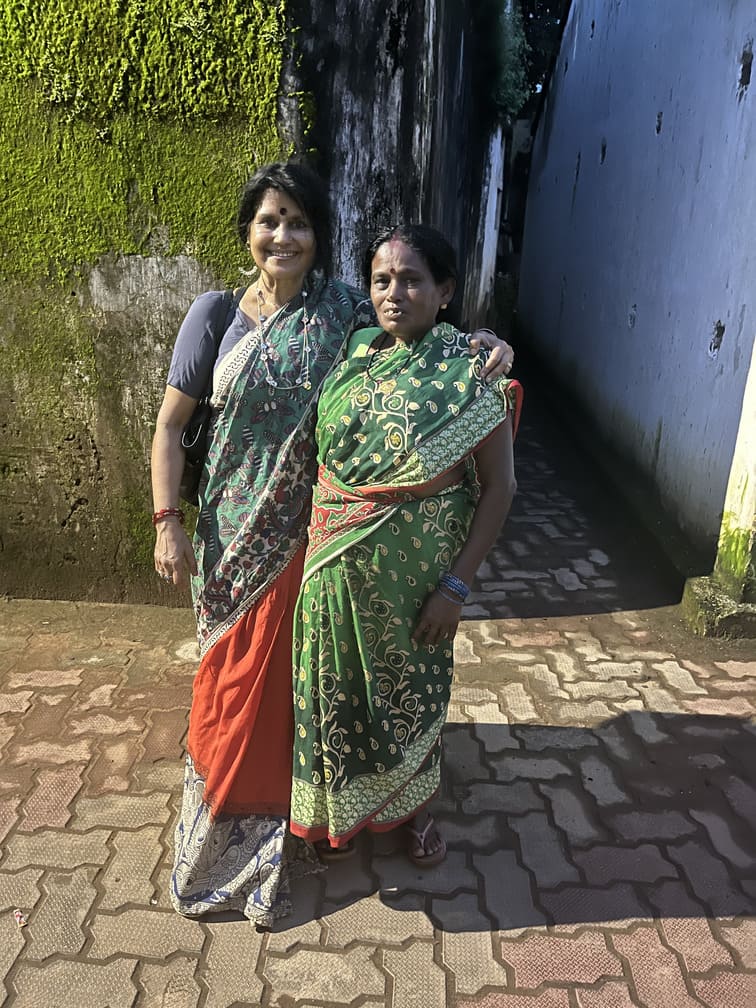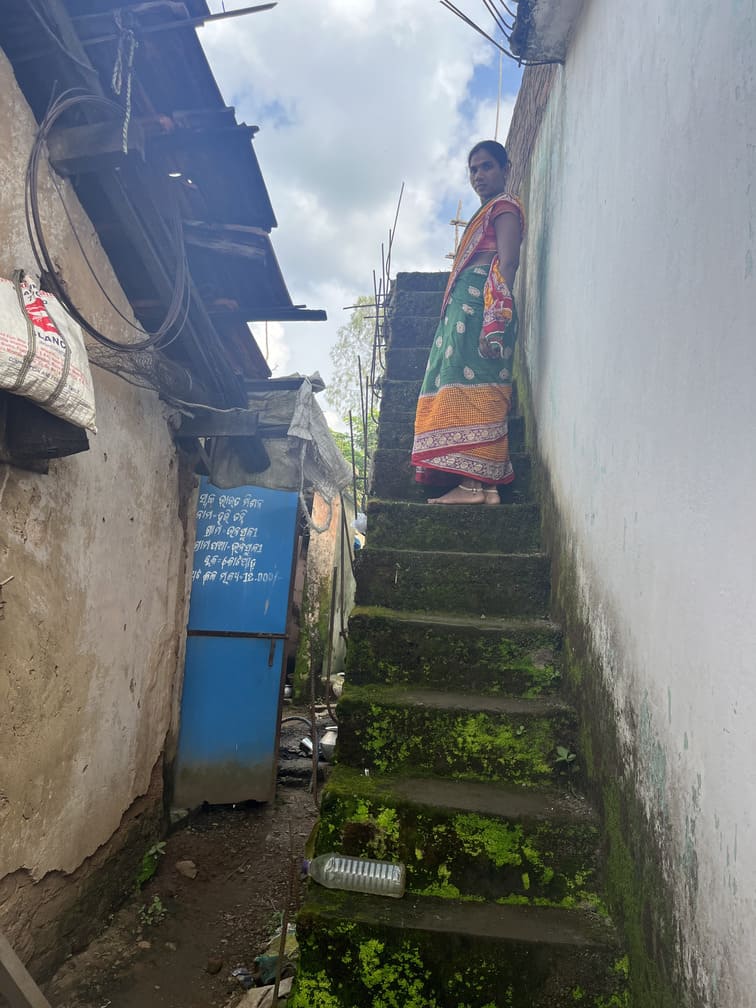On 23rd September, I took a 9-sitter flight, the smallest I have flown in my life, from Bhubaneswar to Jeypore to learn about the Panikas, the weavers of Kotpad textile who traditionally weave clothes for their tribal neighbors. The weave is named after the town Kotpad. It is known for the organic coloring of the thread and the indigenous motifs, which have become very popular in the international market. The flight took about an hour and 45 minutes to pass through Odisha’s forests, mountains, and rivers, covering 580 km.

I checked into a newly built hotel, The Balkrishna Palace, and took a taxi to Kotpad to visit the weavers. We passed through sprawling Cornfields (the market is flooded with sweet corn, a new hybrid variety), paddy (the Kotpad area is famous for scented rice and black rice), and miles and miles of eucalyptus trees, locally known as Neelagiri (used to make paper). The corporations encourage the villagers to plant these fast-grown trees in cleared forest areas and sell them in three years to make a quick profit. But it has devastating consequences. Nothing else will grow in the same land, and these trees suck up all the water underground. Recently, Capetown, South Africa, went through ground zero without a single drop of water because of the colonial gift of these trees covering the hills, the only water source for the population.
I spent a week interviewing the Panikas and their neighbors, Tantis, and it was a wonderful learning experience.
I arrived at Kotpad town around 2:30 p.m. The Kotpad bazaar was marked by a statue of smiling Gandhi and the ubiquitous sign, ‘I love Kotpad,’ a recent state initiative in every corner of the State. Raju Mahanta, a Panika in his early 30s, my contact in Kotpad, welcomed me to his home. When I arrived, Raju’s wife, Bobby, was drying big loads of colorful Kotpad flaps – Indigo, white, and traditional red – commissioned by the Reliance textile company, owned by Ambani, the most affluent family in Asia. On the other side of the entrance, Kotpad stoles, red and white with tribal motifs, were coloring the space.
I entered their pukka house leading to the living room with a sprawling sofa and mounds and mounds of Kotpad saris, dress material, stoles, and towels covering room space horizontally and vertically. A cloth rack was also loaded with saris.

On the wall was a picture of Kapileshwar Mohanto, Raju’s father, receiving the award for his weave from President Abdul Kalam in 2006. Sudha, Mohanto’s wife, does the organic dying of the thread, the most laborious process done exclusively by women in the community. Dying is a seasonal job, impossible in the rain. It starts in December and continues till July.
Mohanto and his wife were very warm and welcoming. Mohanto calls himself a master weaver, technically a trader who commissions saris from the Tantis and sells them under their banner in the market. He has two looms in a shed outside his house, a handloom, and a modified pit loom given by the state government. They look unused.
Mohanto follows the lineage of the Panika weavers – his father lived up to age 85, and his grandfather was 120. Mohanto’s family of twelve members – three sons, their wives, and grandchildren live under the same roof.
Who are the Panikas?
Panikas are a weaving caste who are Kabir Panthis (followers of Kabir) and find their trace in the neighboring State of Chhattisgarh. Sant Kabir, the 15th-century Bhakti poet, was a weaver who spread equanimity irrespective of religion. Mohanta says traditionally, they are vegetarians. Now, the Panikas eat non-vegetarian food. They are also known as Mirgans, a title the Raja of Jeypore conferred on them for singing melodious bhakti songs. Mir is known as chili; their soulful voice was like hot chili. Bidya Mohanto, a Panika from the community, sang beautiful bhakti songs for me. Raju Mohanto is the president of Siridi Sai and is involved in building a Sai temple in Kotpad town. They consider religion as a service to contribute to the community.
There are about 100 to 120 Panika families spread in one neighborhood. They are all related to one another by blood or marriage. I was told that only 5,6 families do weaving. In the entire neighborhood, I saw only one active loom and wondered where the Kotpad saris were produced. I came across a signboard for the Weavers Cooperative Society (WCS) Kotpad. Mohanta says this Society needs to be more active. The members are supposed to give the Kotpad material to the Society to sell to government stores. Still, the master weavers sell the products independently for more profit and quick pay.
Who does the Kotpad brand weaving?
Panikas and Tantis: A Close Collaborative Business Relationship
Tantis are spread in nearby villages, predominantly Dangiriguda and Hanshuli. Since the number of Mirgans making the Kotpad sari dwindled in the 1990s, the govt has promoted the Tantis to weave these saris, has trained them with the help of Panika weavers and now they are the primary weavers of Kotpad clothing. They used to weave plain clothes earlier. I met 67-year-old Jagababndhu Samartha, a president’s awardee for sari design, who taught the Tantis to weave Kotpad saris. Today, his vision is poor; he had surgery on one eye and cannot weave.
Each of the seven Panika master weavers I met has commissioned at least 10 – 20 Tanti families to produce the Kotpad brand. They weave products like Saree, Dress and shirt material, Duppata, Shawl, stole, and gamaccha (towel). Tantis have mastered Kotpad weave but are yet to know organic coloring exclusive to the Panika women. Now, they are learning to make the dyeing with the help of govt trainers. Madhaba Tanti from Dangariguda says they have learned only 25% of the dyeing process. Increasingly, they use chemical colors for the sari, dress material, and secret acid to make it colorfast.
Panikas consider themselves a higher caste than the Tantis and treat them as their subjects. They make financial investments with Tantis, pay for the thread and labor, and sell the Kotpad products as their brand. The Tantis are not recognized for their production and contribution to this Kotpad weave’s growth.
How long a sari take to weave?
The price of the sari is determined by the days of labor tied to the intricate design and the cost of the thread. Some cotton saris with intricate designs will take two people up to 14 days of work. Hari Tanti says that the thread cost to weave a cotton sari is about Rs. 2000, and five days of full-time labor for two people is Rs. 3000. They will sell the sari to the master weaver for Rs. 5000, and he will add his profit. Hari Tanti’s wife weaves along with him. She learned to weave only after marriage and has been weaving for ten years. The saris cost Rs. 8000 ($100) to 14,000 ( $175), and the making is laborious. The thread price has gone up, hence the cost of the sari.
Kotpad Weaves Old and New
In the past, the Panikas wove dhotis, a special taraf pata for weddings for the tribals. This 3-meter-long organic cotton fabric had a plain red or black border. The color in the garment came from the Aal tree root. In the last few decades, the state government realized their unique, organic coloring, combining Aal roots, flowers, wood ash, and Harida (gallnut), and asked them to make 6-meter saris. Kotpad handloom fabric is the first item from Odisha that received the Geographical Indication ( GI) of India tag in 2005. It authenticates the originality of the product tied to the place.
Today, the Kotpad weave has gone beyond traditional cotton saris – tussar saris, dress material, shawls, stoles, and towels.
Initially, the Panikas used pit looms through pedals, about 2 feet dug under the ground. The base of the pit loom is stronger than the handloom. Samarth, an experienced weaver, says the finer designs made possible on the pit loom may not be feasible on the frame loom or handloom sponsored by the Government through the cooperatives in the village. The modern weave is more homogenous and gives a new look to the traditional weave. Samarth’s sari, woven about 20 years ago, is a masterpiece; the design is the same front and back, impossible in a handloom. He says the perfect design is in mind, and one has to use the mental faculty for the correct thread count, like two threads wide and four long, to depict it in the textile.
Modern looms sit above the ground, and two people use it sitting on either side of the bench and weave, coordinating with each other through hand and foot movements. The rainy season is not conducive to weaving on pit loom. The ground, about two feet deep, where the weaver runs the foot pedals for weaving, may get flooded, ruining the sari, and the weaver’s health is affected by sitting on the rain-soaked ground and the feet dipped in the groundwater for hours and days.
Why is the number of weavers in Kotpad so low?
In the last decade, despite the Government patronage, the Kotpad youth is less inclined to weave because it is labor-intensive and time-consuming. One must spend 8 to 10 hours on the loom, often with a partner, to make Rs. 300 daily. The young people refrain from engaging in this labor-intensive, low-paying, and uncertain-wage labor. They can make much more by working in the nearby National Mining Development Corporation (NDMC) service sector. Some go for small businesses such as tea and Paan stalls or become private drivers. I saw the buses from Kerala making rounds in the Kotpad market a few times a day. I was told the buses come to pick up labor to run various facilities in Kerala, causing their lack of interest in weaving.
The Panikas, honored with State and national awards, are forming a class separate from other weavers who resent them for their money and power. They become the master weavers, and their national recognition has helped them connect with many Government and social elites. Their brisk business, leading to sudden wealth, has created a new hierarchy among the Panikas. I was surprised that the master weavers and their adult children are mainly interested in marketing their products but not in weaving.
Alcoholism in the village
There are a dozen liquor stores in and around Kotpad town, and people beeline to buy liquor. Earlier, Mahanta said people drank Mahua liquor on festive occasions, but now the chemically processed liquor is an everyday phenomenon. I wanted to meet the president of the local weavers cooperative in Dangari Guda, but he was asleep in the middle of the day. His wife took saris from the cloth bundle in the Almirah in a thatched house and could not tell me the price. Two young children were loitering in the rain. She said her husband knows but is drunk and will not wake up soon.
Prahlado Mohanto, a Panika, owns a local Kotpad clothing store. He sells the saris nationally and internationally through contacts. When I was sitting at his store, people from faraway cities of Bhubaneswar and Sambalpur came and addressed him as Padmasree. His status helps brisk sales in his business.
The use of Social Media
During COVID-19, social media – Facebook, Instagram, and WhatsApp broadcasting has helped many of these master weavers spread their name and fame, bringing them much more business. The tech-savvy children of some of the master weavers have helped them promote their businesses. Social media has helped those with access to the social and economic capital.
Conclusion In the era of globalization, Kotpad saris have traveled far and wide, but capitalism has seeped into the community. The traditional value of the organic sari has created new capitalists in the community. The Panikas and Tantis have formed a new alliance for mutual convenience and benefit. We, the global customers, are interested in the symbolism as do-gooders but need more time and interest in discovering the roots of what we wear and the changing value of that culture reflected in the saris.







